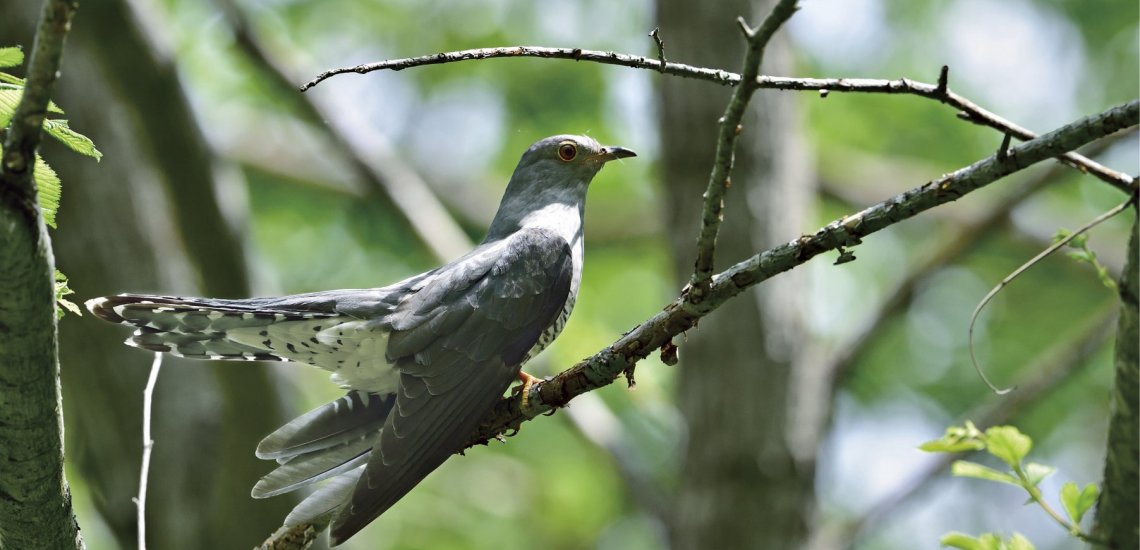
Parasitic Birds and Parasitized Host Birds
“In a quiet lakeside forest
The cuckoo is calling for you,
‘It’s time to wake up,
cuckoo, cuckoo, cuckoo, cuckoo, cuckoo, ,,,”
Most Japanese know the above song, which is sung over the melody of the worldwide popular nursery rhyme, “Incy Wincy Spider”. I feel refreshed whenever I hum it in the morning, as it is really suitable for this pleasant season of May. Four species of the cuckoo family come to Japan around the middle of May from South Asia, telling us that summer has come. I would like to show you photos of three species of them, except Hodgson’s hawk-cuckoo, which I have never succeeded in photographing yet, and also introduce “Brood parasitism”, their unique breeding habit they have in common.
Brood parasitism is a habit of a bird, which does not make its own nest, lays eggs in other bird’s nest secretly and relies on the host bird to raise the chick. To the host, the nest owner and the tentative parents to the chick, it is nothing but an annoying event. The cuckoo family bird chooses a nest whose owner has just started laying eggs, takes away one egg of them and lays one of her own. This egg hatches a little earlier than the other eggs of nest owner, and moreover the chick, with eyes still unopen and no feather developed yet, puts all the host’s eggs on its back and pushes them out, so that it exclusively occupies the whole nest. Thus the chick thrives on the food its tentative parents carry for its now-dead “tentative siblings”, until it has grown much bigger that the host parents and then leaves the nest.
The cuckoo family birds could be personalized as mothers who force the task of childcare totally to other birds, as if they are sweet-faced confidence women. Thanks to brood parasitism, cuckoos have been relieved from chick-raising and ended up with obtaining the possibility of laying more eggs and, as a result, reproducing more offspring than other birds. In the remote past, their ancestors must have raised the young by themselves. It is yet made clear what led them to have such a parasitic behavior. Although it is an extremely particular case, brood parasitism can be said to be one of the ways of living created during the course of biotic evolution, and maybe an example of successful child raising. However, nest owners wouldn’t stay totally fooled. While repeatedly being forced to host other species’ eggs, they become hostile to cuckoos coming close to their nests and attack them. Some nest owners become able to distinguish eggs and throw away those laid by other species, against which cuckoo family birds fight back by developing even more tactical skills of brood parasitism.
The cuckoo family bird looks like a bird of prey in its flight and appearance as well, having stripes on the tails and breast. In order for its act to be unnoticed by the host bird, taking advantage of such similarity, it scares and leads the host bird to leave the nest, and quickly lays its own egg. Also the color and pattern of its egg tends to resemble to that of the egg of each host. It lays eggs similar to those of the host to avoid being noticed by the nest owner. While individuals, a little wiser than the others, have continued reproduction, the cuckoo family birds must have evolved the skillful parasite technique. Hence we have seen physical and mental battle between the parasite and the host species. Their relationship is quite interesting.
As a result of over-specializing in parasitism, cuckoo family birds have abandoned the relationship not only between parents and children, but also of husband and wife in raising chicks, and among mates as well, so they have come to live lonely all through life. Now even in a situation where they could reproduce offspring more easily and take care of the chick by themselves, it would be impossible for them to return to the habit they used to have long ago. Thinking of their circumstances, I cannot but feel there is something melancholic in their appearance and voice.
